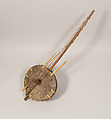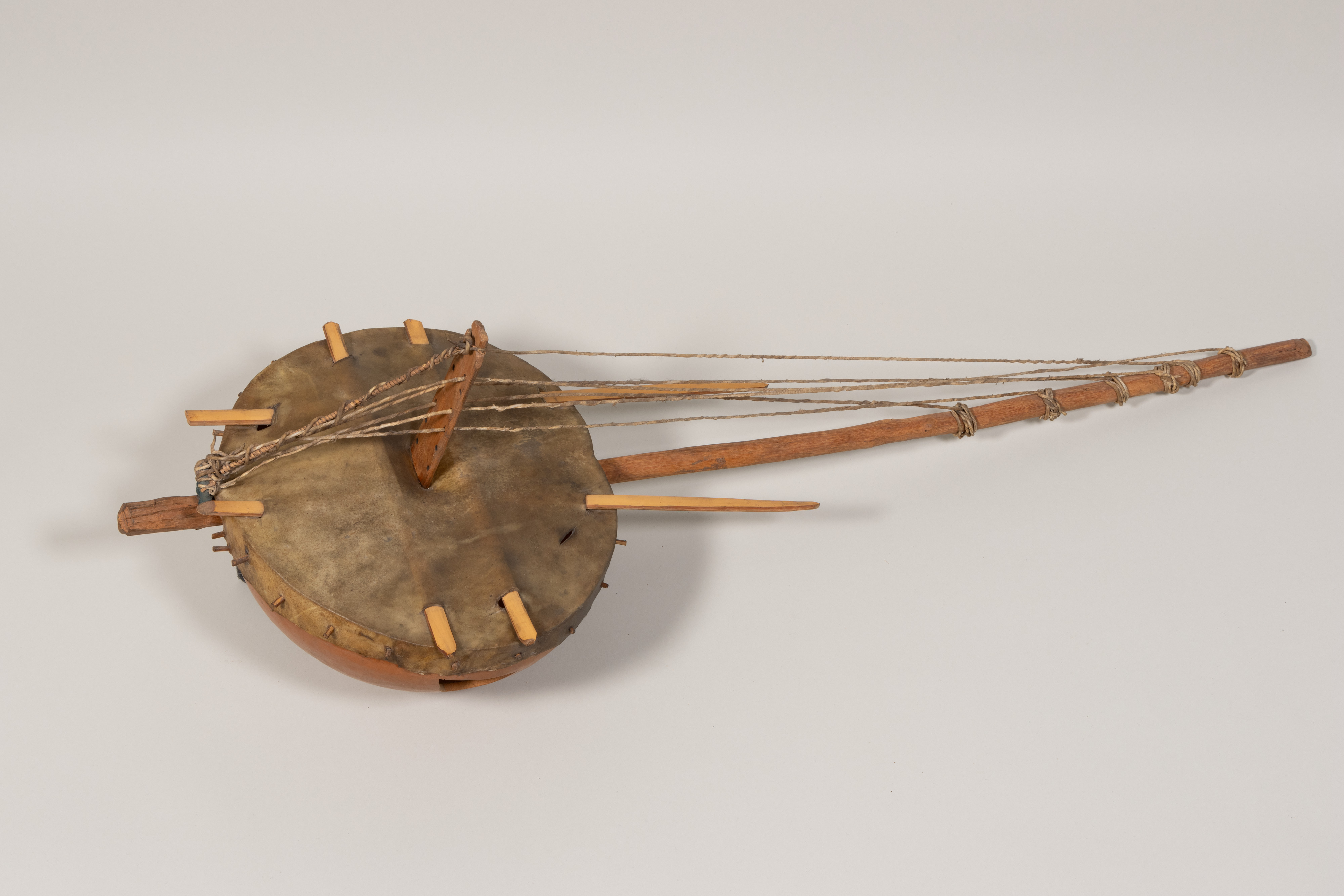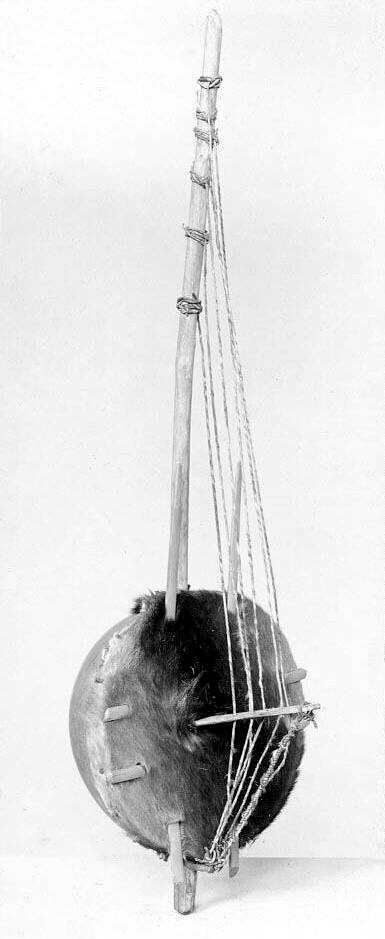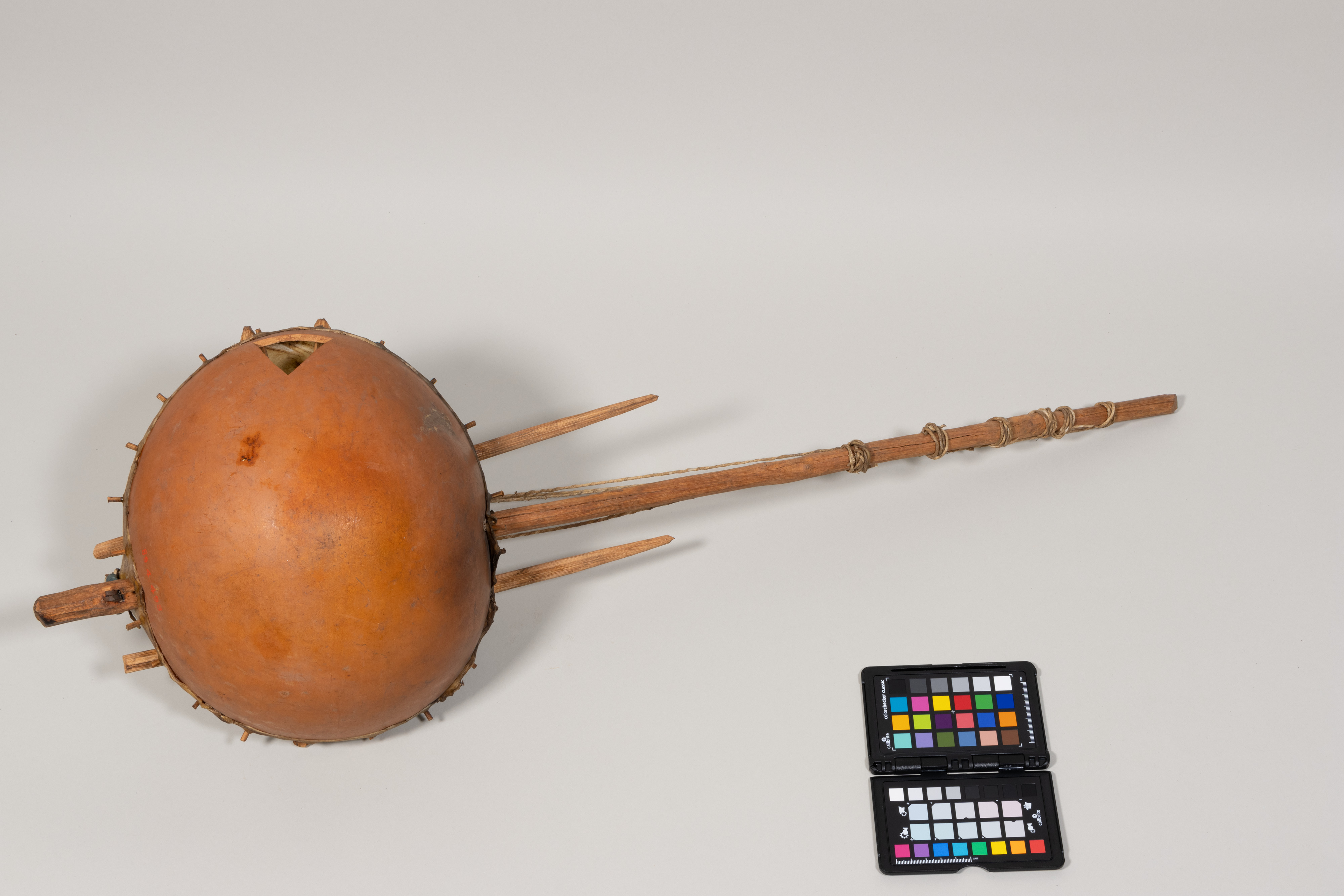Sora Ngoni (Simbingo)
Not on view
This hunter’s harp, or sora ngoni, comes from the Mandé region of West Africa, which refers to the geographical shadow of the Mandé empire (1235-1469 A.D.), including present-day Mali, Senegal, Guinea, Guinea-Bissau, and the Gambia. In the Maninka language, a hunter’s musician is called sora (also sewa, sera, serewa, or dewra). Ngoni is the generic term for these kinds of harps.
This hunter’s harp exhibits five structural components common to West African harps in general: first, its neck is fitted with tuning rings; second, it has a gourd as a resonator; third, it has a sound table made from an animal skin; fourth, it has an upright string holder or bridge; and finally, and perhaps most unique to the Mandé region, it is a spike harp, which means that the neck of the instrument extends all the way through the resonator and protrudes from the bottom end. Both spike harps and harps with upright string holders or bridges are considered indigenous to West Africa.
The emphasis on hunters as foundational to Mandé society cannot be understated. Broadly speaking, sora, or hunters, are part of a historic occupational group called the nyamakala. The nyamakala are distinguished from their horon (noble-born) and jon (slave, now a largely defunct category) counterparts by dalilu, or spiritual powers, passed down through fasiya, or patrilineage, through which they are able to wield nyama, or dangerous forces. Specifically, a sora acts as an intermediary between hunters and supernatural forces in the forest. For example, praise of both the hunter and his kill through sora song neutralizes the nyama released in death. References to hunters abound in Mandé oral traditions, most notably in the Sunjata epic, where simbon, or master hunters, are cited as the immediate ancestor to the story’s hero.
In the Mandé world, there is little social distinction within hunter societies, leading Malian scholar Youssouf Cissé to come to the conclusion that they predate the “rigid structure of Malinke society” and the spread of Islam (1964: 176). Hunter’s harps, in particular, do not rely on the iron tools of blacksmiths, and therefore may predate the beginnings of metalworking in West Africa in the mid-first millennium B.C.E., not long after reliance on agriculture as a food source developed in the Mandé region. In the event of drought and/or famine, hunting may have been critical to survival, resulting in the elevation of hunters as heroes (Cissé 1964: 189; Bird 1972: 276 and Charry 2000: 67). It is possible, therefore, that hunter’s musicians’ practices were developed not long after reliance on agriculture became widespread, making their practices one of the oldest not only represented in the Met’s collection of Mandé instruments but which is also still practiced in the Mandé region today.
This particular hunter’s harp has a long, straight neck that pierces half of a small gourd. The gourd is covered with an animal hide that is secured by wooden pegs. Four pieces of wood hold up the hide sound table: on either side of the bridge, two parallel and two perpendicular to the instrument’s neck. The instrument’s six twisted strings, which are looped onto the neck, pass through half of the bridge’s twelve holes. They have then been tied to an iron ring attached to the bottom of the gourd, around which a cloth is tied as well. The bridge is held in place by a wound material that matches the strings and is also tied to the cloth loop at the instrument’s base. There is a triangular sound hole cut in the side of the gourd.
All of these characteristics put together, this instrument most closely resembles hunter’s harps found in the Guinea/Guinea-Conakry region. Specifically, it is likely a hunter’s harp of the Loma (also Loghoma, Looma, Lorma or Toma) of Guinea (Huchard 2000). The Loma are a small ethnic group that live primarily in Guinea and Liberia. They are socially and historically closely related to the Mende people, although their language is related to the Southwestern branch of Mandé languages. Loma harps in particular, as is the case with this instrument, feature bridges with more holes for strings than there are strings, which are either strung or not for symbolic reasons. (Althea SullyCole, 2022)
References:
Bird, Charles S. 1972. “Heroic Songs of the Mande Hunters.” In African Folklore, edited by Richard Dorson. Bloomington: Indiana University Press: 275-93.
Charry, Eric. 2000. Mande Music: Traditional and Modern Music of the Maninka and Mandinka of West Africa. Chicago: University of Chicago Press.
Cissé, Youssouf. 1964. “Notes sur les sociétés de chasseurs malinké.” Journal des Africanistes 34, no. 2: 175-226.
Huchard, Ousmane Sow. 2000. La Kora. Dakar: Presses Universitaires de Dakar.
This image cannot be enlarged, viewed at full screen, or downloaded.
This artwork is meant to be viewed from right to left. Scroll left to view more.






